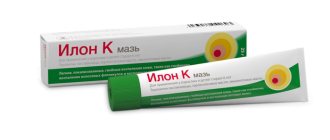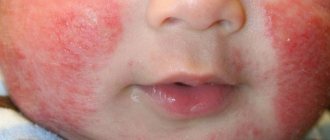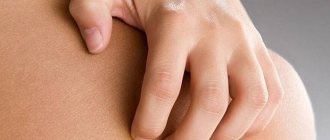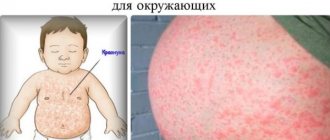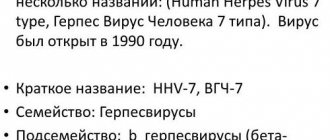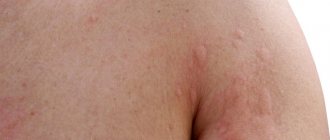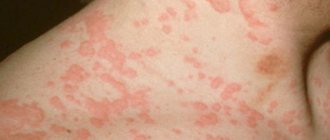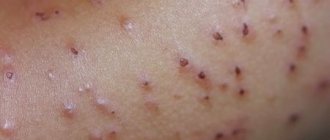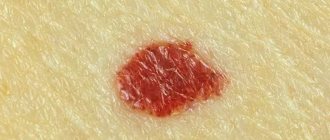Development of the disease
Chickenpox, like many other diseases, is divided into several time periods, each of which has its own characteristics and external manifestations of the infection. There are 4 of them in total:
- The incubation or latent period of the disease, also called the latent form. This period of time, as a rule, has no external manifestations, since the virus initially adapts and multiplies in the body. Invading the cells of the upper layers of the epidermis and mucous membranes of the mouth, nose or throat, the virus replaces the cellular DNA chain in the protein production system with its own chain. At the same time, the cell continues to function in a normal rhythm, producing not protein material, but a virus, which gradually accumulates in the cell, after which the cell disintegrates and the virus is released into the body, affecting other cells, and everything repeats. Thus, the causative agent of chickenpox multiplies and provokes the appearance of local foci of infection. Then, the virus is spread by the bloodstream and lymphatic fluid throughout the body, causing infectious poisoning (intoxication). At this same stage, the body begins to produce specific glycoproteins (antibodies) to combat the “undesirable form of life”, which later, transforming into another form, form stable immunity against the chickenpox virus. How many days does chickenpox last in latent form in adults? Typically, the time period for this period is from 10 to 21 days from the moment of direct contact with the disease. Statistically, this period for adult members of society is 14-18 days;
Note that information about the virus is entered into the immune memory, like in a notebook, and the next time it enters the body, the immune system instantly reacts to it and the production of “weapons” begins immediately. It follows from this that the causative agent of the disease simply does not have time to develop to the scale of infection, since it is neutralized by the body’s natural defense system very quickly.
- Prodromal or precursory period of the disease. It is generally accepted that this stage is characterized by the first symptomatic manifestations of the disease, which resemble the manifestations of a common acute respiratory infection:
- Increased body temperature reaching 39-40 degrees;
- Weakness and lethargy of the whole body;
- Headache, often acute;
- Pain in muscles and joints throughout the body;
- Fever and chills;
- Spasms and convulsions of individual muscle groups, involuntary twitching of the limbs is possible;
- Nausea, vomiting;
All these manifestations are characteristic of chickenpox and appear due to the body’s reaction to the infection, and some symptoms arise due to viral damage to the pain receptors of the nervous system. How long does this stage last? As a rule, it is 2-3 days;
- Period of appearance of the rash. The name speaks for itself; this stage is characterized by the appearance of the first elements of exanthema, which are localized on the skin of the patient’s face and scalp (in the scalp). Primary rashes have the form of red-pink spots - roseola. In general, the chickenpox rash is polymorphic in nature, that is, it transforms and changes. On the very first day after the spots appear, the rash begins to take the form of papules: nodules (small compactions) form in the central part of the roseola and resemble small pimples. In addition, the localization of the rash grows, new elements of exanthema appear throughout the patient’s body, with the exception of the palms and feet. In this form, the rashes remain for 24-48 hours, after which they change again, transforming into characteristic vesicles: the pimples are filled with a clear liquid containing a huge amount of the virus, and increase in size, forming blisters, which eventually dry out and become covered with a characteristic brown crust. How long do chickenpox rashes last in adults? Depending on the degree of the immune response and the severity of the viral infection, this period can vary from 6 days to 12 days;
Note that chickenpox rash is often accompanied by severe itching. Scratching the rash is strictly prohibited, as this creates a risk of bacterial infection, which can significantly complicate the course of the disease.
- Recovery stage. This period of time is characterized by a decrease in the aggression of symptoms and signs: the temperature drops to 37 degrees or slightly higher, and eventually normalizes, new foci of exanthema do not appear, and old ones are either already crusted over or have dried out. This all points to the retreat of the infection and a speedy recovery. After the appearance of the last foci of exanthema, after 5-6 days the person is considered healthy;
As you may have noted, there is a range in the duration of the stages of infection, so in order to understand the question: “How long does chickenpox last in an adult?”, we will further consider the typical forms of the disease, which differ in varying degrees of aggressive manifestations and duration of the course.
Care tips.
As of 2021, a strong surge in chickenpox infections is expected.
During the course of chickenpox in children, many symptoms are present, including itching. Severe scabies causes multiple discomforts, partially disrupts the functionality of the central nervous system, and also aggravates the condition of the skin.
If chickenpox starts, the baby will feel itching constantly, with intermediate improvements. To stabilize the patient's condition, it is necessary to reduce this symptomatic manifestation, guided by the following methods:
- Since the child is prescribed bed rest, use accessories made from natural cotton fabrics. This will ensure full air circulation and eliminate discomfort from skin contact with bed linen.
- Change clothes daily or every two days. With chickenpox, there is a high temperature, accompanied by profuse sweating. Changing things in a timely manner will reduce skin irritation.
- Thoroughly ventilate the children's room. If it is hot, the child will sweat, which will lead to the appearance of new blistering neoplasms and the spread of redness.
- Keep your nails short. It is forbidden to comb the vesicles that appear, as wounds and later scars form in their places.
- The child should be given as much fluid as possible, while making sure that he has fresh and clean things. All negative substances that provoke the formation of new blisters are eliminated with sweat.
Important: to reduce itching, choose light, loose clothing that does not cause discomfort when in contact with the patient’s body.
Forms of infection
Chickenpox has 3 main (typical) forms:
- Mild nature of the infection. In adult members of society, this form is quite rare. The appearance of a mild course of the disease is more typical in childhood. This form of the disease is characterized by a relatively low and short increase in temperature (37-38 degrees). The rashes are few and form on the chest, face, head, abdomen, limbs and shoulders. Lasts no more than 5 days;
- The moderate nature of the disease is common among adult patients. It is accompanied by an increase in body temperature above 38 degrees, and the rashes are profuse and appear everywhere, including the mucous membranes. New elements of the rash appear within 6-8 days;
- Severe form of the disease. Just like the previous form, it occurs quite often in adult individuals. It is characterized by a prolonged increase in body temperature within 39-40 degrees. The rashes are numerous and appear everywhere, including the mucous membranes, groin area, and genitals. A rash may appear on the visual organs and around the eye area, but this is rare. New lesions appear within 10-12 days;
How to relieve itching with chickenpox.
It is not enough to simply eliminate symptomatic manifestations; you need to do this safely, without exacerbating the allergic reaction. How to relieve itching in a child with chickenpox can be read in the article.
To solve the uncomfortable problem, different groups of medications are used, including antiallergic, antihistamine, and sedatives.
To safely relieve itching from chickenpox, a group of medications with a calming effect, based on natural ingredients, is most often used. Qualified pediatricians recommend using:
Leovit. A medicine produced in the form of jelly. There are a variety of flavors (raspberry, banana, apple). It has a pleasant taste, the product contains no sugar, which eliminates the possibility of increasing an allergic reaction.
Kissel for children Leovit allows you to reduce irritation and also calm the agitated central nervous system.
Homeopathic Nott's drops . They eliminate acute allergic reactions and interact gently with the child’s body. Pediatricians prescribe the medicine to children from 1 year of age.
Edas . Homeopathic remedy. Allows you to calm the central nervous system and has a hypnotic effect. Does not harm the child's body.
Valerianahel. An analogue of valerian root, but intended for use by children for itching due to chickenpox in children. The medicine is available in various forms (drops, tablets). Among the advantages of the medication, it is worth noting its speed of action, reduction of symptomatic manifestations of chickenpox, and elimination of itching.
For very severe scabies, it is necessary to use potent homeopathic medicines such as Phenozepam or Phenibut. Before use, you should carefully read the package insert and take into account possible side effects.
Note: When giving your child any medicine, watch how his body interacts with the active ingredients of the drug. If the medication causes hyperactivity, increased excitability or drowsiness, it is recommended to change the medication or seek advice from a pediatrician.
Chickenpox is a viral disease, so it is rational to use a group of antihistamines that prevent the further development of the infection. The drugs are potent, effective and fast-acting. After 2-3 doses, the main symptoms, including itching, will noticeably decrease. But take antihistamines with caution, as they can cause multiple side effects, such as:
- gagging;
- diarrhea;
- increase the allergic reaction if incompatible with the active components of the drug;
- cause drowsiness, decreased physical activity;
- excite the central nervous system.
The modern pharmacological industry has made a huge step in solving this problem. On pharmacy shelves you can find drugs with a minimum number of side effects. To relieve itching from chickenpox in children, use:
Suprastin . The most popular remedy for chickenpox itching, intended for all age groups. Stops the course of a viral infection and significantly reduces attacks of scabies. There are some side effects, but the effectiveness of the product outweighs the obvious disadvantages.
Zodak. A safer analogue of Suprastin. There are several forms of release, including drops for oral administration. Before taking, you should read the instructions for use.
Cetrin and its analogue Cetirizine . Fast-acting drugs that briefly relieve itching and symptomatic manifestations. The medicine helps reduce the number of rashes on the skin.
A group of antihistamines partially affects the mucous membrane and causes temporary problems with coordination and attention. Unfortunately, many children have a pronounced incompatibility with the main components of drugs, and therefore often require the selection of safe analogues from a qualified pediatrician. The advantages include a positive effect on the excited central nervous system. Antihistamines soothe the baby, reduce itching, scabies and burning, and also prevent the development of new blistering neoplasms.
The third category of medicines for the effective elimination of scabies are antipruritic drugs for external and oral use. It is worth noting that simultaneously taking several medications with similar specific effects can provoke an overdose and intensify the allergic reaction. This leads to serious consequences, including imbalance in the gastrointestinal tract, pathological migraines and an increase in the area of rashes.
Effective antipruritic drugs prescribed for children include the following drugs:
Gel-like medication Fenistil . The medicine produces a double effect - antipruritic and analgesic. With long-term use, it eliminates the symptomatic manifestations of chickenpox.
Viferon. Used to relieve swelling and stimulate natural regeneration of the skin. Classified as an immunomodulatory substance.
Iricar stands out especially . Reduces scabies, relieves itching in children with chickenpox. The drug is completely safe for small children.
La Cree. Antipruritic and anti-inflammatory cream to relieve swelling and burning. The composition contains exclusively natural ingredients, including mountain herbs, which have a powerful therapeutic effect.
If your baby's skin does not itch too much, use a proven home method - a soda solution. For 200 ml of warm water you will need 1 teaspoon of baking soda. Rinse the affected areas with the resulting solution, and then put on clean clothes.
Important : self-prescription of medications is strictly prohibited, even if you are confident in the safety of the drug and its compatibility with the child. For treatment to be effective, without complications, you need to consult a pediatrician or therapist. All medications are prescribed by a highly specialized specialist, including dosages.
How long does chickenpox last in adult men and women?
In fact, chickenpox is absolutely unimportant to a person’s gender, so the duration of the disease in women and men is the same.
Based on the above information, we can derive average figures. How many days does chickenpox last in an adult? If we take the moment of onset of symptoms as the starting point, the duration of the disease will be 12-21 days. If we take the actual infection with chickenpox as the starting point, the duration of the disease will be 26-39 days.
What is the contagious period
At various stages of the disease, a person is able to secrete infection in various ways. So, before determining the contagious period for chickenpox, it is worth noting that large quantities of the pathogen are found in saliva, and with the appearance of a rash, also in the blisters. When they burst, they can infect others. During this period, chickenpox can be transmitted by airborne droplets.
The duration of this period can vary significantly; it all depends on the severity of the disease and ranges from nine days to three weeks.
How many days is chickenpox contagious?
In general, this period can be divided into three stages:
Advice from Doctor Komarovsky.
Well-known children's pediatrician Dr. Evgeniy Komarovsky focuses on the fact that chickenpox is a common disease and does not deserve panic. From the doctor’s point of view, every child between the ages of 3 and 5 years should get it.
The doctor recommends avoiding frequent use of a group of antihistamines, including medications for external use. As a last resort, you can use the medication Fenistil, which is the safest for the child’s body.
Evgeniy Olegovich strongly recommends providing the child with appropriate sanitary conditions, balancing the diet, ventilating his room, and changing personal belongings, especially underwear. If you eliminate the main factors that cause sweating, your baby will recover faster.
source
How to calm a child.
Constantly itchy skin greatly worries the child and has an unpleasant effect on his well-being and mood. Infants and children under 2 years of age may constantly cry, be capricious, and refuse to take milk or other food. Itching also has a negative effect on daily routine. The baby sleeps during the day and is awake at night, lacking proper sleep. Some medications will help relieve itching from chickenpox and calm your baby.
To quickly eliminate unpleasant symptomatic manifestations, as well as calm the baby, the following drugs are used:
Nervochel. A potent sedative that has undergone appropriate safety testing. The product not only relieves itching, but also anesthetizes the affected areas of the skin. Recommended for children aged three years and older.
Shalun granules . Used for particularly restless children. A neurological drug that calms the agitated central nervous system and promotes a positive mood in the baby. Has a hypnotic effect.
Mint or chamomile infusion . You can purchase a pharmacy sedative that contains these herbs. Chamomile is famous for its antiseptic and disinfecting properties. Mint acts as a sedative.
It is not recommended to give strong medications to breastfed children. It is better to use folk remedies based on natural ingredients. Infectious disease specialists recommend healing herbal baths of low concentration. If there is a need to use drugs, you can purchase Fenistil in drop form. But, it is important to remember that if the dosages and instructions for use are abused, uncontrolled complications may occur.
Among the external means that can calm children, one can highlight Calamine lotion. It dries out blisters and also reduces redness. It must be applied carefully, without destroying the vesicular growths.
Note: a variety of pharmacological ointments and creams are proven remedies for itching with chickenpox. Before direct use, you need to consult a highly specialized specialist regarding compatibility with foreign drugs.
What to do if you have severe itching.
It was previously noted that an allergic reaction can occur in mild and severe forms. The latter type is characterized by severe itching, high fever and a large area of rash. What to do in this situation?
Initially, you need to contact a highly specialized specialist (preferably a dermatologist or infectious disease specialist) to select appropriate drugs from the group of antihistamines. Most often, doctors prescribe Loratadine, Zyrtec, Zodak, Fenistil, based on the baby’s personal health indicators. All medications have several therapeutic properties: sedative, antipruritic, anti-inflammatory and antiseptic. The best option would be to use Fenistil in gel form for external use.
In this video, a qualified pediatrician will give some recommendations on the topic of itching with chickenpox.
